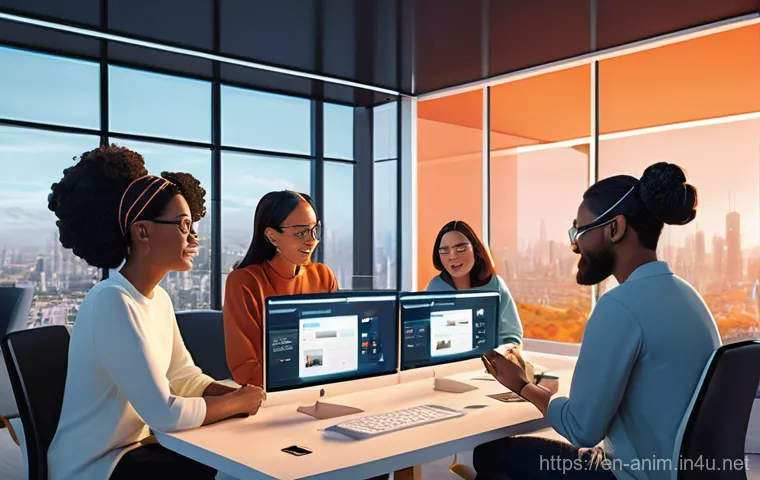Hey there, fellow animation enthusiasts and studio pros! We all know that bringing an animated world to life is pure magic, but behind every stunning frame and captivating character lies a mountain of meticulous planning and relentless effort.
I’ve been in this amazing industry long enough to see firsthand how exhilarating – and let’s be honest, sometimes utterly chaotic – long-term animation projects can be.
The traditional ways of juggling spreadsheets and endless email chains? They just don’t cut it anymore when you’re dealing with complex pipelines, distributed teams across time zones, and the constant pressure to deliver breathtaking quality on tight deadlines.
It’s a real balancing act, isn’t it? From ensuring every artist feels empowered, not overwhelmed, to keeping that creative spark alive through years of production, effective project management isn’t just about ticking boxes; it’s about nurturing vision and talent.
I’ve experienced the frustration of miscommunication and the triumph of a perfectly executed plan, and believe me, having the right system in place makes all the difference.
The good news is, the landscape is evolving fast! With cutting-edge tools like AI-powered workflow optimization, enhanced real-time rendering, and advanced machine learning capabilities, alongside smart strategies like agile methodologies, we’re seeing incredible shifts that are automating labor-intensive tasks and making the impossible, possible.
So, if you’re ready to transform your studio’s approach and bring those epic stories to the screen more smoothly and profitably than ever before, stick around.
Let’s uncover the secrets to mastering long-term animation project management together and make your next big hit a resounding success!
Unlocking Seamless Workflows: The Power of Smart Planning

Diving into a long-term animation project feels a bit like embarking on an epic journey. You know your destination, but the path can be full of unexpected twists and turns. From my own experience, the biggest game-changer isn’t just having a map, but a GPS that can reroute you in real-time. We’re talking about transitioning from rigid, waterfall-style planning to a more dynamic, responsive system. I’ve seen firsthand how an initial, overly optimistic schedule can crush morale six months in when realities set in. That’s why I’ve become such a huge advocate for adaptive planning. It’s about building flexibility into the very foundation of your production, allowing for creative exploration and problem-solving without derailing the entire timeline. Think of it as laying down tracks that can adjust to the terrain, rather than trying to force the landscape to fit your tracks. This approach really helps mitigate those unforeseen hurdles, whether it’s an artistic challenge, a technical glitch, or even a sudden change in scope. Trust me, your team will thank you for the breathing room!
Phased Milestones for Momentum
Breaking down a monumental project into manageable, phased milestones isn’t just good practice; it’s essential for maintaining momentum and keeping the finish line in sight. When I worked on “Galactic Guardians,” a project that stretched over three years, we deliberately structured our pipeline into smaller, more digestible phases, each with its own clear deliverables and review gates. This wasn’t just about checking off tasks; it was about celebrating small victories along the way. Each successful phase—be it concept approval, character rigging completion, or the first pass of animation for a key sequence—provided a much-needed psychological boost. It gave the team a tangible sense of accomplishment, reinforcing their progress and keeping motivation high. Without these regular checkpoints, the sheer scale of a multi-year project can feel overwhelming, leading to burnout and a dip in creative energy. It’s like running a marathon; you need those markers to remind you how far you’ve come and how much closer you are to the end.
Automating Tedious Tasks to Free Up Creativity
One of the most exciting shifts I’ve witnessed recently is the rise of automation in animation pipelines. Honestly, I used to spend countless hours on mundane tasks—file management, version control, rendering queue setup—tasks that, while necessary, drained energy that could have been spent on actual creative work. Now, with smart automation tools, we’re seeing these processes streamlined, sometimes even completely handled by AI. This isn’t about replacing artists; it’s about empowering them. Imagine an animator getting back several hours a week because the system automatically handles naming conventions, sorts assets, and even flags potential errors before they become major issues. I’ve seen this dramatically reduce frustration and significantly increase throughput. It’s a clear win-win, allowing our talented artists to focus on what they do best: bringing stories and characters to life, rather than wrestling with administrative burdens.
Empowering Your Crew: Cultivating a High-Performance Studio Culture
Building an animation studio capable of delivering long-term projects isn’t just about technology or planning; it’s fundamentally about people. I’ve always believed that the heart of any successful studio lies in its culture—how people interact, how they feel valued, and whether they feel safe to take creative risks. In my career, I’ve observed that a truly high-performing team isn’t just a collection of talented individuals; it’s an ecosystem where everyone feels ownership and understands their critical role in the grand tapestry. This means fostering an environment of open communication, mutual respect, and continuous learning. When artists feel heard, when their concerns are addressed, and when their contributions are genuinely appreciated, they don’t just work harder; they work smarter and more passionately. It’s about creating a psychological safe space where creativity can truly flourish without fear of judgment. This dedication to culture isn’t a soft skill; it’s a strategic imperative that directly impacts project success and team longevity.
Investing in Continuous Skill Development
The animation industry is constantly evolving, with new software, techniques, and artistic styles emerging all the time. To keep a long-term project on the cutting edge, and more importantly, to keep your team engaged and growing, continuous skill development is non-negotiable. I remember a period where a new rendering engine was introduced mid-project, and the initial resistance from some artists was palpable. However, by providing dedicated training sessions, workshops, and even online courses during work hours, we not only brought everyone up to speed but also sparked a newfound enthusiasm for exploring its capabilities. This investment sends a clear message: “We believe in your growth, and we’re committed to equipping you with the tools you need to excel.” It’s not just about addressing immediate project needs; it’s about nurturing long-term career paths within your studio. When your team sees that you’re invested in their future, their loyalty and commitment to the project will soar. It’s a small expenditure with massive returns in terms of expertise and morale.
Promoting Psychological Safety and Open Feedback
I’ve worked in environments where fear of failure stifled innovation, and I’ve worked in places where brave ideas were encouraged, even if they sometimes fell flat. The difference was always psychological safety. For animation projects that can last years, creative iterations and sometimes even pivots are inevitable. If artists are afraid to suggest new approaches, or to admit when something isn’t working, you’re missing out on vital problem-solving power. Establishing channels for constructive criticism, anonymous feedback, and regular one-on-one check-ins creates an atmosphere where ideas can be freely exchanged without ego getting in the way. I personally found that when team leads genuinely listened and acted on feedback, it built immense trust. It transforms potential criticisms into opportunities for collective improvement, ensuring everyone feels they have a voice in shaping the project. This open dialogue is the bedrock of resilience in a demanding, creative field.
Leveraging Next-Gen Tech: AI, ML, and Real-time Rendering Unleashed
The technological leaps we’ve seen in animation over the last few years are nothing short of astounding, and I’ve been fortunate enough to integrate some of these innovations into projects I’ve worked on. Forget what you thought you knew about animation pipelines; AI, machine learning, and real-time rendering aren’t just buzzwords anymore—they’re becoming indispensable tools that are fundamentally changing how we approach long-term productions. I’ve personally experienced the sheer power of having AI assist with tasks that used to take days, like complex crowd simulations or generating preliminary facial animation. This isn’t about replacing human artistry; it’s about amplifying it, allowing artists to achieve more ambitious visions with unprecedented efficiency. These technologies are truly the unsung heroes behind the scenes, enabling teams to push creative boundaries while staying within demanding schedules and budgets. When you start seeing these tools as extensions of your team’s capabilities, that’s when the real magic begins.
AI-Powered Optimization for Every Stage
From concept art generation to final compositing, AI and machine learning are weaving their way into every thread of the animation fabric. I recall a particularly challenging project where we needed to generate thousands of unique texture variations for an alien landscape. Traditionally, that would have been a Herculean task for our texture artists, demanding weeks of repetitive work. However, by employing ML algorithms that learned from initial art direction, we were able to procedurally generate a vast library of high-quality, consistent textures in a fraction of the time. Similarly, AI-driven tools are now assisting with things like automated in-betweening, preliminary motion capture cleanup, and even smart rigging suggestions. This doesn’t just speed up the process; it also frees up our highly skilled artists to focus on the truly creative and nuanced aspects of their craft, knowing that the foundational, often tedious work is being handled intelligently and efficiently. It’s truly empowering to see technology serving creativity in such profound ways.
The Game-Changing Impact of Real-time Rendering
If there’s one technological advancement that has truly revolutionized long-term animation projects, it has to be the widespread adoption of real-time rendering. I remember the agony of waiting hours, sometimes even overnight, for a single frame or a short sequence to render, only to find a tiny error that required another agonizing render cycle. This painstaking process not only devoured time but also stifled iterative creativity. With real-time rendering engines, that bottleneck has largely been eliminated. Now, directors, animators, and lighting artists can see their work evolve instantly, making immediate adjustments to composition, lighting, and performance. I’ve witnessed firsthand how this accelerates decision-making and reduces costly reworks. It allows for a far more fluid and experimental creative process, letting teams try out multiple ideas rapidly and land on the best one much faster. For projects stretching over years, this immediate visual feedback is invaluable, preventing costly miscommunications and keeping everyone aligned with the creative vision. It’s genuinely transformed the iterative design process, making it faster and far more intuitive.
Mastering the Art of Agile: Iteration for Animation Perfection
When I first heard about “agile methodologies” being applied to animation, I was a bit skeptical. Animation felt too inherently linear, too dependent on a strict pipeline, for something born in software development. But my mind was quickly changed after seeing its transformative power on a particularly complex feature film. Traditional animation pipelines can often feel like a massive train, once it’s on a track, changing direction is a monumental effort. Agile, on the other hand, encourages smaller, iterative cycles, often called “sprints,” which allow for constant review, adaptation, and refinement. It’s like having a highly maneuverable modular vehicle instead of a fixed train. This flexibility is crucial in long-term projects where creative directions can evolve, and new challenges are constantly emerging. Instead of waiting until the very end to discover a major flaw, agile allows teams to identify and address issues much earlier, saving immense amounts of time and resources down the line. It’s truly a smarter way to work, reducing risk and fostering innovation through continuous feedback loops.
Sprint Cycles for Targeted Progress
Implementing sprint cycles has been one of the most effective strategies I’ve seen for maintaining focus and achieving consistent progress in multi-year animation productions. Instead of a vague goal of “finish animation by next year,” teams focus on specific, achievable objectives within a two-to-four-week sprint. For example, a sprint might be dedicated to completing all keyframe animation for a particular character in a specific scene, or finishing the first pass of lighting for a sequence. At the end of each sprint, the team conducts a review, assessing what worked, what didn’t, and how to improve for the next cycle. This iterative approach keeps everyone aligned and accountable, but more importantly, it provides regular opportunities for creative input and course correction. I’ve found that these frequent, tangible accomplishments keep the team motivated and engaged, transforming what could feel like an endless journey into a series of achievable quests. It breaks down the overwhelming into the manageable, which is key for sustained effort.
Adapting to Change: Flexibility as a Superpower
Let’s be real, in animation, change is the only constant. Whether it’s a script revision, a new creative directive from the director, or unexpected technical hurdles, projects rarely unfold exactly as initially planned. This is where the inherent flexibility of agile truly shines. Instead of seeing changes as disruptive setbacks, an agile framework allows you to embrace them as opportunities for improvement. I remember a project where, halfway through, the art director decided on a significant stylistic shift for an entire environment. In a traditional pipeline, this would have caused a massive headache, potentially leading to months of rework and budget overruns. But because we were working in agile sprints, we were able to quickly re-evaluate, adjust our backlog, and allocate resources to tackle the new direction in upcoming sprints, integrating the changes far more smoothly. This ability to adapt gracefully, without losing sight of the overall vision, is an incredible superpower for long-term animation projects, ensuring that the final product is not just complete, but truly reflects the latest and best creative decisions.
Budgeting Beyond Basics: Smart Financial Strategies for Creative Giants

Let’s talk about something that might not sound as glamorous as character design or visual effects, but is absolutely critical for long-term animation success: smart budgeting. I’ve been involved in projects where brilliant creative visions almost collapsed under the weight of unforeseen financial pressures, and I’ve also seen projects thrive because of meticulous, forward-thinking financial management. It’s not just about tracking expenses; it’s about strategic allocation, proactive forecasting, and understanding the financial implications of every creative decision. For a project that spans years, your initial budget is merely a blueprint, not a fixed dogma. You need a system that allows for dynamic adjustments, recognizing that creative exploration often requires financial flexibility. My personal philosophy is that budgeting should serve creativity, not stifle it. It’s about empowering your team to deliver their best work within realistic financial parameters, avoiding those agonizing moments where you have to cut corners that impact quality.
Proactive Forecasting and Risk Mitigation
One of the biggest lessons I’ve learned about long-term project budgeting is the importance of proactive forecasting. It’s not enough to just review expenditures at the end of the month. You need to be constantly looking ahead, anticipating potential cost overruns, and identifying areas where you can optimize spending without compromising quality. I remember on one project, we foresaw a potential bottleneck in rendering farm capacity during a peak production phase. By analyzing our resource usage and projecting future needs, we were able to negotiate a better deal with an external render farm provider well in advance, saving us a significant amount of money compared to a last-minute scramble. This kind of foresight, coupled with robust risk mitigation strategies, can make or break a multi-year project. It’s about having contingency plans for unexpected events, whether it’s a technical failure, a key artist leaving, or a major change in scope. Being prepared financially allows you to weather these storms without derailing the entire production.
Leveraging Analytics for Cost-Effective Decisions
In today’s data-driven world, even animation budgeting benefits immensely from analytics. By tracking production data—like the average time spent on specific tasks, render times per shot, or even the cost per character asset—you can gain invaluable insights into your efficiency and identify areas for improvement. I’ve seen studios use this data to make more informed decisions about staffing, tool investments, and even outsourcing. For example, if analytics show that a particular type of asset creation is consistently exceeding budget and time estimates internally, it might be more cost-effective to explore specialized external vendors for those elements. This isn’t about micromanaging; it’s about making data-backed decisions that optimize your resources. It ensures that every dollar spent is contributing effectively to the project’s success, maximizing your creative output within your financial constraints. It truly transforms budgeting from a necessary evil into a powerful strategic tool.
Connecting the Dots: Communication Strategies for Global Teams
In our increasingly interconnected world, it’s rare to find a long-term animation project that isn’t leveraging talent from across the globe. While this distributed model opens up incredible opportunities to tap into diverse skill sets and perspectives, it also introduces significant communication challenges. I’ve personally navigated projects with artists in Los Angeles, Bangalore, and Seoul, all collaborating on the same sequences. The traditional “walk over to someone’s desk” approach simply doesn’t cut it. Effective communication isn’t just about sending emails; it’s about building bridges across time zones, cultural nuances, and different working styles. It requires intentional effort to create robust, clear, and empathetic communication channels that ensure everyone is on the same page, feels heard, and remains connected to the core vision of the project. Miscommunication is a silent killer of long-term projects, leading to costly reworks and frayed nerves. So, mastering this aspect is absolutely crucial for success.
Synchronizing Across Time Zones
The sheer logistics of synchronizing a global team can be a nightmare if not handled correctly. I’ve tried every trick in the book, from rotating core meeting times to designated “overlap hours” where everyone commits to being online. What I’ve found works best is a hybrid approach, combining synchronous meetings for critical discussions with robust asynchronous tools for daily communication and feedback. For example, daily stand-ups might be recorded and shared, allowing team members in different time zones to catch up at their convenience. We often scheduled our most vital reviews during a window that was manageable for both East Asian and North American teams, even if it meant a few early mornings or late nights. It’s about finding that sweet spot of overlap and utilizing tools that allow for seamless information exchange regardless of when someone is active. This thoughtful scheduling ensures that no one feels consistently excluded or overworked due to time differences, maintaining team cohesion and efficiency.
Leveraging Unified Communication Platforms
Gone are the days of scattering project communication across disparate email threads, instant messaging apps, and cloud storage services. For long-term animation projects, a unified communication platform is an absolute non-negotiable. I’ve experienced the frustration of trying to track down a crucial piece of feedback that was buried in an old email chain or a forgotten chat group. Modern platforms, integrating project management features, real-time chat, video conferencing, and centralized asset sharing, streamline everything. They become the single source of truth for the project, making it easy to share files, provide contextual feedback directly on assets, and hold virtual meetings that feel almost as effective as in-person ones. The ability to quickly pull up past discussions, track decision-making, and access relevant documents instantly saves countless hours of searching and prevents misinterpretations. It’s like having a virtual central hub where every team member, regardless of their physical location, feels connected and fully informed.
Sustaining the Spark: Nurturing Creativity Over the Long Haul
Working on a multi-year animation project is a marathon, not a sprint. While the initial burst of creative energy and excitement is always exhilarating, maintaining that spark, that passion, over years of intricate work, is one of the biggest challenges for any studio. I’ve personally seen how the grind can wear down even the most enthusiastic artists, leading to creative fatigue and a dip in the overall quality of work. Nurturing creativity isn’t a luxury; it’s a strategic necessity for ensuring a project not only gets completed but truly shines. It’s about understanding that your team members are more than just cogs in a machine; they are artists who need inspiration, a sense of purpose, and opportunities for rejuvenation. The final product will always reflect the energy and passion that went into its creation, so keeping that fire alive is paramount.
Encouraging Creative Exploration and ‘Playtime’
It might sound counterintuitive in a tight production schedule, but allocating dedicated time for creative exploration, even “playtime,” can be incredibly beneficial for long-term projects. I’ve often championed initiatives where artists get a small percentage of their work week to experiment with new techniques, explore personal side projects, or simply brainstorm without immediate production pressure. I remember on one particularly demanding project, we introduced “Innovation Fridays,” where everyone could work on something outside their immediate tasks, as long as it related to pushing the boundaries of animation or storytelling. The ideas that emerged from these sessions were astounding, with some even finding their way back into the main project, adding fresh perspectives and unexpected solutions. This isn’t just a perk; it’s an investment in your team’s creative wellspring, preventing burnout and keeping their artistic muscles limber and engaged. It reminds them why they fell in love with animation in the first place.
Celebrating Milestones and Recognizing Contributions
In the long journey of an animation project, celebrating milestones is absolutely crucial for morale and for reinforcing the team’s collective progress. I’ve found that simply finishing a sequence or hitting a major production benchmark without acknowledgment can leave artists feeling like their hard work goes unnoticed. Whether it’s a small team lunch, a virtual celebration for distributed teams, or a simple company-wide email highlighting individual and team achievements, these moments of recognition are incredibly powerful. On one project, after hitting a particularly tough animation deadline, our director brought in a local food truck, and everyone just relaxed and shared stories. It was a simple gesture, but it fostered an incredible sense of camaraderie and appreciation. It’s about making sure every single person feels valued for their contribution, reminding them that they are part of something bigger and that their dedication is truly seen and appreciated. These moments of collective joy help recharge batteries and strengthen the bonds that make a team resilient over years.
| Feature | Traditional PM (e.g., Spreadsheets, Email) | Modern PM (e.g., Specialized Software, AI Tools) |
|---|---|---|
| Task Tracking & Assignment | Manual updates, prone to errors, difficult to visualize dependencies. | Automated assignments, visual dashboards, real-time progress updates, dependency mapping. |
| Resource Management | Static allocation, challenges in rebalancing workloads quickly. | Dynamic resource allocation, AI-powered load balancing, skill-based task matching. |
| Communication & Collaboration | Disjointed email threads, lost feedback, version control issues. | Integrated chat, centralized feedback loops, version history, shared asset libraries. |
| Timeline & Scheduling | Rigid Gantt charts, difficult to adapt to changes, manual recalculations. | Flexible timelines, instant impact analysis for changes, predictive scheduling, agile sprints. |
| Budget Oversight | Separate financial spreadsheets, delayed reporting, limited real-time cost analysis. | Integrated budget tracking, real-time expenditure monitoring, predictive cost analytics. |
| Quality Control | Manual review processes, siloed feedback, inconsistency across teams. | Automated quality checks (e.g., asset validation), consistent review workflows, AI-assisted bug detection. |
Closing Thoughts
Whew, what a journey we’ve been on, right? Navigating the intricate world of long-term animation projects can feel like directing your own epic saga, full of triumphs and unexpected challenges. But as we’ve explored together, it’s truly a journey where the right blend of innovative tech, smart planning, and a deeply human touch can make all the difference. I’ve seen firsthand how exhilarating it is to watch a complex vision come to life, frame by meticulous frame, and it’s clear that the future of animation is brighter and more efficient than ever. Remember, it’s not just about the tools you use, but how you empower your incredible team and adapt with grace. Keep that creative spark alive, keep pushing boundaries, and most importantly, keep nurturing the amazing talent that makes all this magic possible. Here’s to your next blockbuster success!
Useful Information to Know
1. Embrace Agility: Don’t be afraid to adopt agile methodologies like Scrum or Kanban. They offer the flexibility and iterative feedback loops essential for adapting to the inevitable changes in long-term animation projects, preventing costly reworks and keeping everyone aligned.
2. Invest in Your Team’s Growth: The animation industry is always evolving. Providing continuous training and opportunities for skill development isn’t just a perk; it’s a strategic investment that keeps your crew engaged, knowledgeable about the latest tools, and motivated to push creative boundaries.
3. Leverage Next-Gen Tech: AI, machine learning, and real-time rendering are not just trends; they’re powerful allies. They can automate tedious tasks, speed up rendering times, and free up your artists to focus on the truly creative aspects, significantly enhancing efficiency and quality.
4. Prioritize Clear Communication: Especially with global or distributed teams, robust communication channels are non-negotiable. Utilize unified platforms and implement smart strategies for synchronizing across time zones to ensure everyone stays informed, connected, and part of the collective vision.
5. Budget with Foresight: Move beyond basic expense tracking. Implement proactive forecasting and use analytics to make informed financial decisions. Having a contingency budget and understanding cost factors unique to animation can prevent overspending and ensure your creative vision isn’t stifled by financial pressures.
Key Takeaways
At the heart of every successful, long-running animation project is a delicate balance of human creativity, strategic process, and technological advancement. We’ve seen that effective project management isn’t just about rigid schedules and strict deliverables; it’s about creating a living, breathing framework that can flex and grow with the artistic endeavor. This means empowering your people with continuous learning and a psychologically safe environment, where their passion can truly flourish without fear of burnout. It means embracing agile methods to navigate the unpredictable twists and turns, ensuring that feedback is a constant, guiding force rather than an afterthought. And, of course, it means intelligently integrating cutting-edge tools like AI and real-time rendering, not to replace human artistry, but to amplify it, automating the mundane so the magnificent can shine through. By focusing on these pillars – your team, adaptive processes, and smart tech – you’re not just managing a project; you’re cultivating a vibrant studio that’s built for sustained creative excellence and profitability, bringing unforgettable stories to audiences worldwide.
Frequently Asked Questions (FAQ) 📖
Q: Why are traditional project management methods failing animation studios today, especially for long-term projects?
A: Oh, this is a question I hear all the time, and for good reason! I’ve personally felt the pain points of relying on older methods when working on sprawling animation projects.
The truth is, traditional “waterfall” project management, with its rigid, linear progression, just isn’t designed for the dynamic, often unpredictable nature of creative endeavors like animation.
You start with a script, move to storyboards, then modeling, rigging, animation, lighting, rendering, and so on, in a strict sequence. But what happens when a director wants to tweak a character’s expression much later in the pipeline, or a new creative vision emerges that impacts scenes already ‘finished’?
Traditional methods make those changes incredibly costly, time-consuming, and frankly, a nightmare to implement. Think about it: we’re dealing with complex pipelines, often with teams spread across different cities or even continents.
Trying to manage endless spreadsheets and email chains for hundreds, even thousands, of assets and shots quickly becomes a chaotic mess. Communication bottlenecks, missed feedback, and version control issues are practically guaranteed.
I’ve seen projects grind to a halt because a small change in one department created a ripple effect of massive rework for others, leading to blown budgets and missed deadlines.
The sheer scale and iterative nature of animation demand a more flexible, responsive approach, something the old ways just can’t deliver effectively anymore.
It really zaps the creative energy when everyone is bogged down in process rather than artistry!
Q: How can cutting-edge technologies like
A: I and machine learning actually transform our animation production pipeline? A2: This is where things get really exciting, and I’ve been blown away by the possibilities I’ve seen emerging!
Forget about AI taking over artists’ jobs; I truly believe it’s here to supercharge our creative process and handle the grunt work that frankly, nobody enjoys.
For example, traditionally, tasks like rigging a complex character or meticulously animating “in-between” frames (tweening) are incredibly technical and time-consuming.
I remember spending countless hours on these, and while essential, they weren’t always the most creatively fulfilling. Now, with AI and machine learning, we’re seeing tools that can automate joint placement and weight painting for rigging, speeding up what used to take days into mere hours.
Imagine that! Even generating realistic human motion from minimal input is becoming a reality, leading to quicker, more natural-looking results without needing full-body motion capture suits for every single movement.
I’ve seen AI-driven systems streamline everything from storyboarding and lip-syncing to complex rendering, allowing animators to preview lighting and shading in real-time.
This isn’t just about efficiency; it means artists can spend more of their precious time on the truly creative aspects – crafting compelling stories, experimenting with new designs, and refining artistic details, rather than getting bogged down in repetitive technical tasks.
It’s like having a brilliant assistant for all the tedious stuff, freeing us up to do what we do best: create magic!
Q: Besides technology, what are the most crucial “people-focused” strategies to keep a long-term animation team motivated and productive?
A: Ah, the human element! Technology is amazing, but ultimately, it’s the people who bring the magic to life. I’ve found that even with the best tech, a demotivated or fractured team can sink a project faster than anything.
For long-term animation projects, where the finish line can feel miles away, keeping spirits high and productivity humming is paramount. One strategy I’ve seen work wonders is embracing agile methodologies.
It sounds like a techy buzzword, but at its heart, it’s about people and collaboration. Breaking down massive projects into smaller, manageable “sprints” with clear, achievable goals gives everyone a sense of progress and accomplishment.
When you can celebrate those small wins along the way, rather than waiting years for the big premiere, it makes a huge difference in morale. Daily stand-ups, even quick 15-minute chats, keep communication flowing and problems from festering.
It helps avoid micromanagement and empowers artists to take ownership of their tasks. Beyond that, fostering a culture of open communication and constructive feedback is non-negotiable.
I always encourage leaders to create an environment where artists feel safe to share ideas, ask questions, and even voice concerns without fear. Providing continuous learning opportunities, recognizing achievements (big and small!), and prioritizing a healthy work-life balance are also critical.
Let’s be honest, long crunch times are unavoidable sometimes, but consistent overwork kills creativity and leads to burnout. I’ve learned that a team that feels valued, supported, and understands how their individual contributions feed into the larger vision is a team that will go above and beyond, making your studio’s next masterpiece not just possible, but a joy to create.






